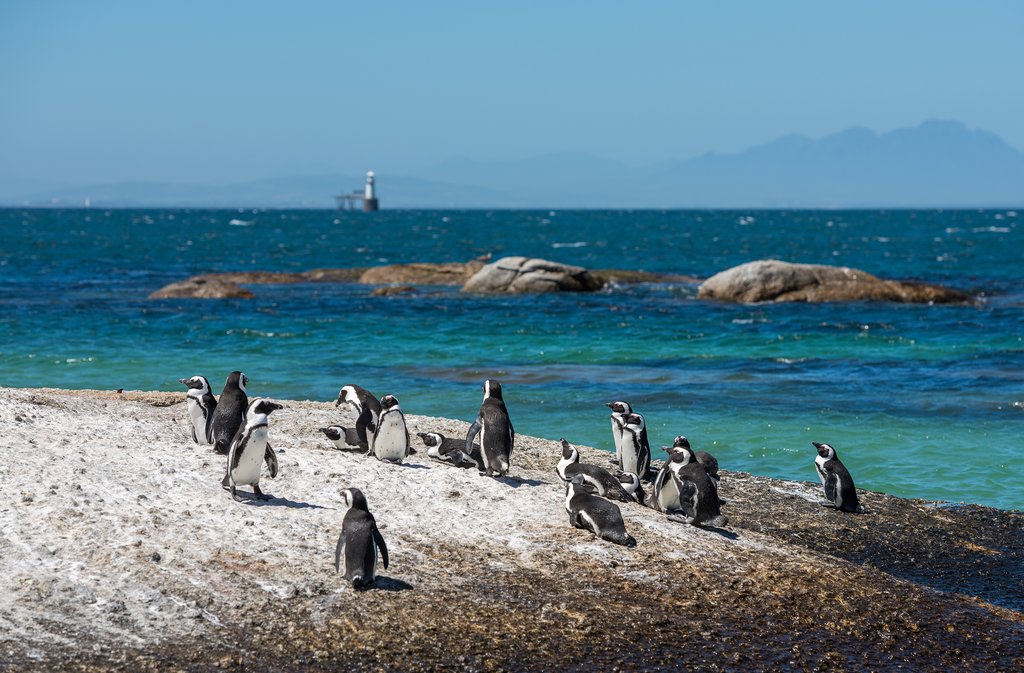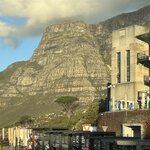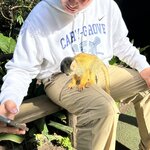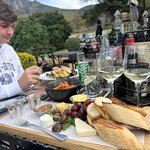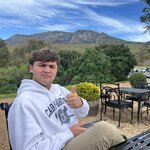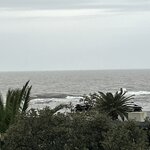Highlights
- Gaze out over Cape Town from atop Table Mountain
- Sip the day away in the Cape Winelands
- Taste the diverse flavors of Cape Town on a food tour
- Learn the lessons of Johannesburg’s historic Soweto Township
- Seek out the Big 5 on a safari through Kruger National Park
Brief Itinerary
| Day | Highlights | Overnight |
|---|---|---|
| Day 1 | Arrive in Cape Town, City Tour & Table Mountain | Cape Town |
| Day 2 | Wine Tour in the Cape Winelands | Cape Town |
| Day 3 | Atlantic Seaboard & Cape Peninsula | Cape Town |
| Day 4 | Cape Town Township & Robben Island Museum | Cape Town |
| Day 5 | Guided Cuisine & Culture Tour | Cape Town |
| Day 6 | Cape Town to Johannesburg & African Dinner | Johannesburg |
| Day 7 | Soweto Township Visit, Traditional Dinner, & Local Storytelling | Johannesburg |
| Day 8 | Safari Arrival Day, Big 5 Night Drive, & Bush Braai | Kruger National Park |
| Day 9 | Big 5 Sunrise Bush Walk | Kruger National Park |
| Day 10 | Full Day in Kruger National Park | Kruger National Park |
| Day 11 | Moholoholo Rehabilitation Centre | Kruger National Park |
| Day 12 | Blyde River Canyon with Three Rondavels | Johannesburg |
| Day 13 | Depart Johannesburg |
Detailed Itinerary
Day 1: Arrive in Cape Town, City Tour & Table Mountain

Welcome to South Africa! Arrive at Cape Town International Airport and transfer to your accommodation to unpack and unwind. After you settle in, spend the rest of your day exploring the city.
Known as the 'Rainbow Nation,' Cape Town and South Africa have a long and complicated history involving a multitude of ethnic and cultural groups. The area's history starts with the indigenous Khoisan and Bantu people, who were the primary residents of the area until the Portuguese and Dutch arrived in South Africa, beginning a centuries-long occupation.
These days, South Africa is home to a diverse population. Roughly 80% of South Africans are of Bantu ancestry from a variety of ethnic groups, each with a distinct language. The remainder of the community is made up primarily of European, Asian (Indian, Chinese, and others from the formerly enslaved and indentured population), and mixed-race (Cape Coloured) ancestry.
Meet your local guide in the city center for a 4-hour walking tour of the historic city. You'll explore the different eras of Cape Town and learn about South Africa's history, as well as the people who shaped it. Stops along the tour include the Company's Garden, Parliament, Green Market Square, The Castle of Good Hope, and the Slave Lodge.
The Company's Garden dates back to the 1650s when European settlers farmed the land to grow fresh produce to replenish ships rounding the cape. Around the corner is the Iziko Slave Lodge, a national history museum dedicated to exploring the history of slavery at the Cape. Since its construction in 1679, the building has functioned as a center for the bustling slave trade (primarily operated by the Dutch East India Company) as well as a government building and supreme court.
Nearby sits the historic Green Market Square, which has served as a slave market, vegetable market, and center for political protests under Apartheid. These days it hosts a flea market with African souvenirs and crafts for sale.
Just down the street is the Castle of Good Hope, South Africa's oldest existing Dutch East India colonial building. On the way, you'll pass by several memorials and monuments, including the We Are Still Here Street Memorial to destitute children and the District Six Museum, which commemorates forced relocation under apartheid.
After strolling the streets of Cape Town, stop for lunch in the city center. In the afternoon, give your legs a rest with a hop-on-hop-off tour aboard the distinctive red open-top bus. Start at the Cape Town City Center Terminal, then take the bus to Table Mountain. From the bus stop, continue to the summit on the cable car for spectacular views of the city, mountains, and ocean. Return to Cape Town in time for dinner at the bustling Victoria & Alfred Waterfront, where you'll find a variety of fine dining restaurants and pubs with views of the ocean.
Day 2: Wine Tour in the Cape Winelands

Start the morning with a pick up from a local guide for a laidback, full-day wine tour through the Cape Winelands. From the minute you step out the door, your experience today is perfectly curated so you don't have to worry about a thing—besides sipping wine.
The Cape Winelands Biosphere Reserve, which extends from the Kogelberg Reserve in the south along the Cape Fold Mountain Chain to the north, is an internationally recognized area within the Western Cape's Floral Kingdom.
You'll spend the day exploring the rolling hills of the Winelands, visiting wineries in the Stellenbosch, Franschhoek, Paarl, or Elgin Wine Regions. Today will be spent eating mouthwatering foods and drinking some of the best wines South Africa has to offer. The region's wineries offer a variety of whites and reds, as well as their own blends and styles. Enjoy the scenery and the beautiful vineyards and white-gabled farmsteads that dot the landscape, then return to Cape Town in time for dinner.
Day 3: Atlantic Seaboard & Cape Peninsula

Today's excursion is the ultimate driving tour. Hit the road with your guide for a full-day adventure on this Cape Peninsula Tour. The Cape Peninsula is a rocky peninsula that juts out into the Atlantic Ocean at the south-western extremity of the African continent. At the southern end of the peninsula are Cape Point and the Cape of Good Hope. On the northern end is Table Mountain, overlooking Cape Town. The southernmost point of the Cape Peninsula has outstanding flora and fauna and is part of the UNESCO World Heritage Cape Floral Region.
Chat with a local specialist who can help organize your trip.
Afterward, head to Simons Town and visit the penguin colony before breaking for lunch at a local seafood restaurant along the water in the sleepy fishing town. Head over to Chapman’s Peak Drive along the scenic roads of the Atlantic Seaboard. You'll pass by Llandudno and Camps Bay beaches, then stop at the iconic Maidens Cove for a quick dip in the water before ending the day.
Day 4: Cape Town Township & Robben Island Museum

Get an early start today for a full day of sightseeing. You'll start your day at one of Cape Town's iconic townships to get to know the local history and meet with residents. Visit with key community leaders to discuss history, culture, politics, as well as current and future socio-economic challenges facing the township.
If it's a Sunday, you're in for a treat—on Sunday mornings, the tour includes a stop at a local church where you can join the congregation in a joyful celebration of community and faith. The South African spiritual experience emphasizes music and gratitude for the people around you—a powerful start to the day.
After lunch, make your way to the Nelson Mandela Gateway at the V&A Waterfront to catch the ferry across the water to Robben Island, located 4.3 miles (6.9 km) west off the shore of Cape Town. Here, the tour guides are former political prisoners who served time at Robben Island.
Robben Island, which means "seal island" in Dutch, has a long and complicated history that spans millennia. Historic use of the island dates back to the indigenous Khoikhoi and Bantu people, with Dutch settlers using the island as a prison since the 17th century. Later, it was used as a whaling station and as a colony for people diagnosed with leprosy, and as a defense station during World War II. The island is also home to a religious pilgrimage site for Muslims—the Moturu Kramat, built to commemorate Sayed Abdurahman Moturu, Prince of Madura, one of Cape Town's first imams who was exiled to the island in the 1740s.
From the middle of the 20th century until the 90s, Robben Island served as a prison for criminals and anti-apartheid political prisoners during South Africa's apartheid years. Nelson Mandela, South Africa's first black president and recipient of the Nobel Peace Prize, was imprisoned on Robben Island for 18 years of his 27-year term for his anti-apartheid activism. Two other Robben Island political prisoners—Kgalema Motlanthe and Jacob Zuma—have gone on to become President of South Africa.
In addition to being a political and cultural site, the South African National Heritage Site and UNESCO World Heritage Site is also a recognized wildlife sanctuary and serves as a safe haven for about 132 species of birds, including some endangered species. Crowned cormorants and black-crowned night herons breed on the island in large numbers.
Tour the prison to learn about the island's history. You'll see Nelson Mandela's former prison room and go for a short drive to see other notable landmarks, like the rock quarry and outbuildings.
After the 3.5 hour tour, return to the mainland in time for dinner.
Day 5: Guided Cuisine & Culture Tour

Spend the day exploring Cape Town's incredibly diverse cultures through an international medium—food. South Africa's multi-cultural culinary influences are as vibrant as the communities where they originate. A lot of the food in South Africa is sourced fresh, so the tastings will depend on the time of year and season.
To understand South Africa's cuisine, you need to understand the country's history. From the indigenous Bantu and Khoisan people to the Dutch and English colonists, the formerly enslaved Indonesian, Madagascan, and East African peoples, and the Indian and Chinese indentured workers and immigrants, the country has a wide variety of ethnic and culinary diversity.
It was South Africa's colorful cultures that prompted Nelson Mandela, a leader of the anti-apartheid movement and the country's first black president, to coin the term 'Rainbow Nation' to describe the country.
One of South Africa's many ethnic groups are the Cape Malays, a name that's derived from the Cape of Good Hope and the Malay people, originally from Southeast Asia and the East Indies. The Cape Malays are the only cultural group of their kind in the world. Originally brought to South Africa from Dutch colonies as enslaved people, political prisoners, or exiles, they trace their origins to communities from India to Eastern Indonesia.
Multiple groups make up the Cape Malay ethnicity, but the commonality which ties them all together is the maize (corn) that serves as the primary food staple. You'll spend part of the day exploring Cape Town's Cape Malay cuisine, as well as others.
Start your guided tour with a walk through the Company's Gardens, established by Dutch colonists as a supply station, to sample Rooibos Tea and Rusks, an Afrikaaner biscuit. Continue to the Earth Fair Market on St. George's Mall to sample local treats from a variety of vendors, then head to the Bo Kaap, the colorful Cape Malay district, for a traditional Cape Malay lunch. Stop in and visit Atlas Trading, a family-owned spice shop that's been in operation since 1946.
From here take the city bus to the trendy suburb of Woodstock to sample craft beer and locally produced gin, then round out the day with a visit to an artisanal chocolate factory.
Return to your accommodation in the late afternoon to enjoy a free evening in the Cape Town city center.
Day 6: Cape Town to Johannesburg & African Dinner

Today you will transfer from Cape Town to Johannesburg with a short but beautiful domestic flight. Check in to your accommodation in Johannesburg, then head out for a full day in the city. Your overnight options range from the historic township of Soweto to the trendy suburbs and city center that are packed with various art galleries, restaurants, markets, and buzzing nightlife.
Johannesburg (also called Jozi, Jo'burg, and eGoli) is South Africa's largest city and one of the world's largest urban areas. The town dates back to 1886 when workers arrived to mine the large deposits of gold. Within a few years, the population of the city had ballooned, with thousands of native African and Indian workers working in the gold mining industry. Due to racial segregation during the Apartheid era, the workers were forced to live in separate townships outside of the city limits. The most famous of these are Soweto (short for South-West Township) and Lenasia, which was home to a large population of South Africans of Indian descent. Several prominent individuals have called the districts home, including Nelson Mandela, Mahatma Gandhi and comedian Trevor Noah.
In the afternoon go on a walking tour of the Maboneng Precinct, a former industrial zone that has been transformed into a vibrant part of the city. Maboneng, a Sotho word for 'Place of Light,' is a fitting name for a neighborhood that has quickly become a center for creative urban artists. Visit art galleries and historical museums, then head to the 50-story Carlton Center for a bird's eye view of the city.
Alternately, spend the afternoon visiting the sprawling Johannesburg Botanical Gardens which grew out of a large rose garden to cover an area of 310 acres.
For dinner head to the Chiefs Boma African Dining Experience Restaurant for an interactive culinary experience that spans the African continent. Enjoy sundowners or craft beer on the deck overlooking the Boma Dam, then meander through the herb garden before sitting down to enjoy your meal to the music of the African Marimba Band. With over 120 options ranging from North African Moroccan Dishes to a "Big 5 Game Kebab" made from five kinds of antelope, you're sure to find something to suit your tastes. After dinner, enjoy a glass of wine and roasted marshmallows over a cozy fire.
Day 7: Soweto Township Visit, Traditional Dinner, & Local Storytelling

In the morning head out for a half-day tour of the Soweto Township. Take a bicycle or yellow tuk-tuk, or stroll around the Orlando West area with your local guide. You'll pass by historical sites and learn the history of this vibrant community.
Soweto's history stems back to the early 1900s when the government began forcibly separating blacks from whites by removing the black population from the city and relocating them into separate areas. These were separated from the white neighborhoods by a cordon sanitaire (sanitary corridor) like a river, road, or industrial area.
The area experienced civil unrest during the Apartheid era, with the most notable riots occurring in 1976. The riots followed a rule that Afrikaans should be the official language for schools of black Africans in the area (most of whom spoke indigenous African languages). Tens of thousands of black students took to the streets to protest the decision. The demonstrators were met with police violence and brutality; several hundred students were killed, and many more were injured.
One of the murdered students was 12-year-old Hector Pieterson. His story became the face of the student uprising after a photo of his body being carried by an older student gained international fame. The Hector Pieterson Memorial Site commemorates the students' bravery.
After stopping by the memorial, enjoy a quiet stroll down Vilazaki Street to see the former homes of Nelson Mandela and Bishop Desmond Tutu and visit the Nelson Mandela Museum. Along the way, you'll pass street vendors selling fresh fruit, snacks, and various African arts—the perfect excuse to stop for a mid-morning treat and a quick shop for souvenirs. Enjoy lunch at a relaxed outdoor restaurant.
Spend the afternoon exploring on your own. In the evening, experience first-hand accounts of Soweto's history from the township's residents. You'll listen to stories of freedom fighters, students from the 1976 uprising, and other key historical figures. Enjoy live art performances and music as you feast on a traditional African dinner under the starry night skies.
Day 8: Safari Arrival Day, Big 5 Night Drive, & Bush Braai

Today you head to the Greater Kruger National Park Reserve, one of South Africa's most remarkable safari destinations. Depending on your preference and timing, you may choose to fly, shuttle with a driver, or rent a vehicle to complete the drive yourself.
The park was created in 1926 when Sabi Game Reserve joined with the adjacent Shingedzi Game Reserve and local farms to create South Africa's first national park. With a rich history and vast landscapes, the park is a must-see destination for unforgettable wildlife experiences.
Within the park, choose from a wide variety of accommodations, from rustic bush lodges and tent camps to luxury all-inclusive resorts. No matter your budget, you'll find unique lodging in a breathtaking landscape.
After arriving at the lodge, take some time to freshen up and relax. Have a drink at the bar to unwind, go for a swim, or stroll around the lodge to stretch your legs after the day's travel.
In the evening, board an open Land Cruiser for your first game drive in the park. The three-hour drive is a thrilling and exciting opportunity to see Africa's big wildlife up close. The Big 5 include elephants, buffalo, rhino, lion, and leopard, and were named by big-game hunters for being five of Africa's most dangerous animals to hunt. Keep your eyes peeled for nighttime animals as you cruise around the park in the comfort of the Land Cruiser. When darkness falls, the tour guides use spotlights to scan the nighttime for nocturnal animals.
Dinner is a bush braai—a South African take on a barbecue. Mouth-watering meats are sizzled to perfection atop an open wood fire—the perfect ending to a long day. After dinner, continue the night drive before returning to your lodge for the night.
Day 9: Big 5 Sunrise Bush Walk

Get an early start this morning for a drive to a remote location along the Olifants River for a four-hour sunrise bush walk. Surges of adrenaline will come aplenty as you spot wild African animals, but your adequately armed ranger will ensure your complete safety. Follow the area's big animals, including elephants, rhino, and lions on foot as you learn about the African bush and observe animals in their natural habitat.
Make sure you wear comfortable shoes or boots and protective clothing against the brush. Don't leave your camera and binoculars at home for this one—there's plenty to see as you follow the river's edge.
Return to the lodge for brunch, then spend a few hours resting and catching up on sleep after your early rise. In the afternoon, head out for another afternoon game drive.
Return to your lodge for dinner and a relaxing evening.
Day 10: Full Day in Kruger National Park

Spend the day exploring the park. The open-sided game vehicle allows for excellent wildlife viewing and photographic opportunities, so keep your camera on hand. Scores of giraffe, zebra, wildebeest, lions, hyenas, and countless other animals call the park home.
An incredible 517 species of park reside in the park, and over 300 Stone Age archaeological sites have been located in the area. You'll also see plenty of evidence of San and Iron Age people from 1,500 years ago in the park, with San art found throughout the entire park.
After a full day of viewing wildlife, return to your lodge for dinner and a relaxing evening.
Day 11: Moholoholo Rehabilitation Centre

In the morning head to the Moholoholo Rehabilitation Center, established for the medical care of injured and orphaned animals and birds. The center offers a unique experience to its visitors, allowing nature lovers to get close to the center's charismatic residents, such as lions and leopards.
The center's main philosophy centers around the idea that awareness is key if we are to save our rapidly disappearing wildlife, and to that end, Moholoholo's work has been featured in many TV shows and series. Wild Orphans, a popular show about young animals at the center, was shown internationally on the National Geographic Channel.
After lunch return to a game lodge for an afternoon game drive. After a long day, return to your accommodation for dinner and an early bedtime.
Day 12: Blyde River Canyon with Three Rondavels

Enjoy a pre-breakfast sunrise walk, then check out of your accommodation and hit the road for your journey back to Johannesburg. Make your way to Blyde River Canyon, one of the world's largest canyons and home to a wide variety of lush subtropical plants. Deep precipitous cliffs set a dramatic stage for the landscape, with the Three Rondavels—huge round rocks that form part of the Panorama Route—towering over the surrounding countryside.
Take in the sweeping views then keep driving to Johannesburg, arriving around 5:00 PM. Spend the night relaxing at your hotel, or head out for dinner at one of the many world-class restaurants in the heart of the city.
Day 13: Depart Johannesburg

Transfer to the airport for your connecting flight home.
